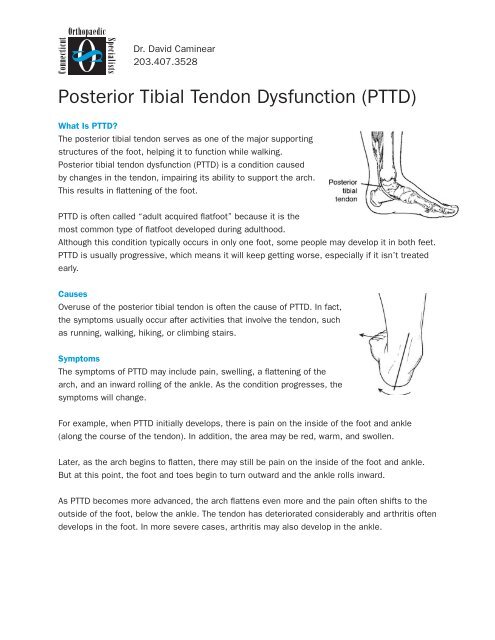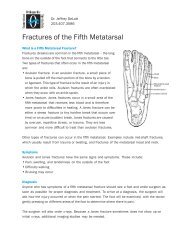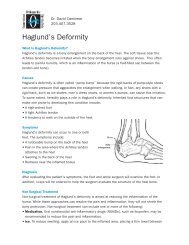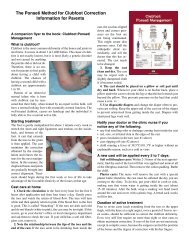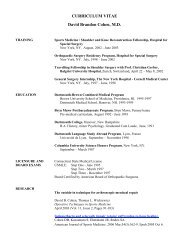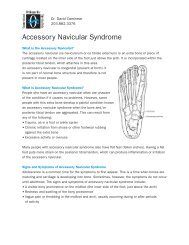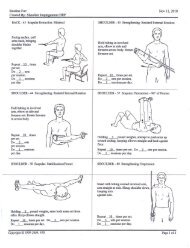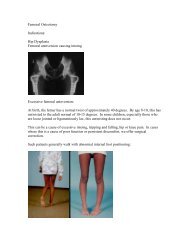Posterior Tibial Tendon Dysfunction (PTTD) - CT-Ortho.com
Posterior Tibial Tendon Dysfunction (PTTD) - CT-Ortho.com
Posterior Tibial Tendon Dysfunction (PTTD) - CT-Ortho.com
You also want an ePaper? Increase the reach of your titles
YUMPU automatically turns print PDFs into web optimized ePapers that Google loves.
Dr. David Caminear<br />
203.407.3528<br />
<strong>Posterior</strong> <strong>Tibial</strong> <strong>Tendon</strong> <strong>Dysfunction</strong> (<strong>PTTD</strong>)<br />
What Is <strong>PTTD</strong>?<br />
The posterior tibial tendon serves as one of the major supporting<br />
structures of the foot, helping it to function while walking.<br />
<strong>Posterior</strong> tibial tendon dysfunction (<strong>PTTD</strong>) is a condition caused<br />
by changes in the tendon, impairing its ability to support the arch.<br />
This results in flattening of the foot.<br />
<strong>PTTD</strong> is often called “adult acquired flatfoot” because it is the<br />
most <strong>com</strong>mon type of flatfoot developed during adulthood.<br />
Although this condition typically occurs in only one foot, some people may develop it in both feet.<br />
<strong>PTTD</strong> is usually progressive, which means it will keep getting worse, especially if it isn’t treated<br />
early.<br />
Causes<br />
Overuse of the posterior tibial tendon is often the cause of <strong>PTTD</strong>. In fact,<br />
the symptoms usually occur after activities that involve the tendon, such<br />
as running, walking, hiking, or climbing stairs.<br />
Symptoms<br />
The symptoms of <strong>PTTD</strong> may include pain, swelling, a flattening of the<br />
arch, and an inward rolling of the ankle. As the condition progresses, the<br />
symptoms will change.<br />
For example, when <strong>PTTD</strong> initially develops, there is pain on the inside of the foot and ankle<br />
(along the course of the tendon). In addition, the area may be red, warm, and swollen.<br />
Later, as the arch begins to flatten, there may still be pain on the inside of the foot and ankle.<br />
But at this point, the foot and toes begin to turn outward and the ankle rolls inward.<br />
As <strong>PTTD</strong> be<strong>com</strong>es more advanced, the arch flattens even more and the pain often shifts to the<br />
outside of the foot, below the ankle. The tendon has deteriorated considerably and arthritis often<br />
develops in the foot. In more severe cases, arthritis may also develop in the ankle.
Non-surgical Treatment<br />
Because of the progressive nature of <strong>PTTD</strong>, early treatment is advised. If treated early enough,<br />
your symptoms may resolve without the need for surgery and progression of your condition can<br />
be arrested.<br />
In contrast, untreated <strong>PTTD</strong> could leave you with an extremely flat foot, painful arthritis in the<br />
foot and ankle, and increasing limitations on walking, running, or other activities.<br />
In many cases of <strong>PTTD</strong>, treatment can begin with non-surgical approaches that may include:<br />
• <strong>Ortho</strong>tic devices or bracing. To give your arch the support it needs, your foot and ankle<br />
surgeon may provide you with an ankle brace or a custom orthotic device that fits into the<br />
shoe.<br />
• Immobilization. Sometimes a short-leg cast or boot is worn to immobilize the foot and allow<br />
the tendon to heal, or you may need to <strong>com</strong>pletely avoid all weight-bearing for a while.<br />
• Physical therapy. Ultrasound therapy and exercises may help rehabilitate the tendon and<br />
muscle following immobilization.<br />
• Medications. Nonsteroidal anti-inflammatory drugs (NSAIDs), such as ibuprofen, help reduce<br />
the pain and inflammation.<br />
• Shoe modifications. Your foot and ankle surgeon may advise changes to make with your<br />
shoes and may provide special inserts designed to improve arch support.<br />
When Is Surgery Needed?<br />
In cases of <strong>PTTD</strong> that have progressed substantially or have failed to improve with non-surgical<br />
treatment, surgery may be required. For some advanced cases, surgery may be the only option.<br />
Your foot and ankle surgeon will determine the best approach for you.


